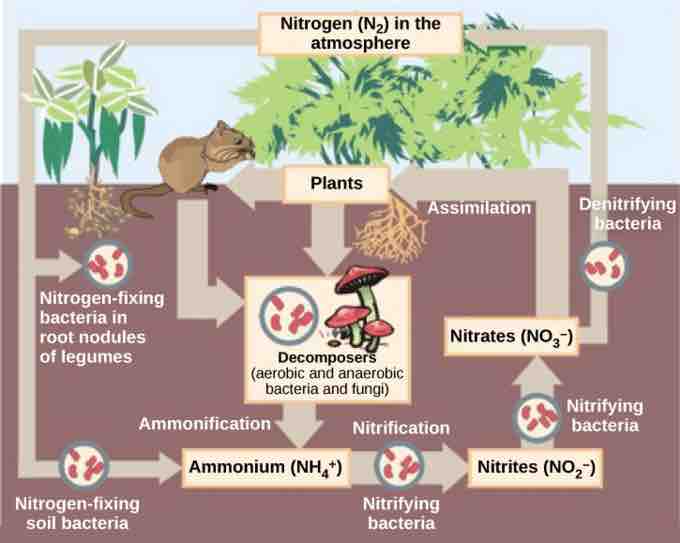Role of Prokaryotes in Ecosystems
Prokaryotes are ubiquitous: There is no niche or ecosystem in which they are not present. Prokaryotes play many roles in the environments they occupy, but the roles they play in the carbon and nitrogen cycles are vital to life on earth.
Prokaryotes and the Carbon Cycle
Carbon is one of the most important macronutrients. Prokaryotes play an important role in the carbon cycle . Carbon is cycled through earth's major reservoirs: land, the atmosphere, aquatic environments, sediments and rocks, and biomass. The movement of carbon is via carbon dioxide, which is removed from the atmosphere by land plants and marine prokaryotes and is returned to the atmosphere via the respiration of chemoorganotrophic organisms, including prokaryotes, fungi, and animals. Although the largest carbon reservoir in terrestrial ecosystems is in rocks and sediments, that carbon is not readily available.

Carbon cycle
Prokaryotes play a significant role in continuously moving carbon through the biosphere.
A large amount of available carbon is found in land plants, which are producers that use carbon dioxide from the air to synthesize carbon compounds. Related to this, one very significant source of carbon compounds is humus, which is a mixture of organic materials from dead plants and prokaryotes that have resisted decomposition. Consumers such as animals use organic compounds generated by producers, releasing carbon dioxide to the atmosphere. Then, bacteria and fungi, collectively called decomposers, carry out the breakdown (decomposition) of plants and animals and their organic compounds. The most important contributor of carbon dioxide to the atmosphere is microbial decomposition of dead material (dead animals, plants, and humus).
In aqueous environments and their anoxic sediments, there is another carbon cycle taking place. In this case, the cycle is based on one-carbon compounds. In anoxic sediments, prokaryotes, mostly archaea, produce methane (CH4). This methane moves into the zone above the sediment, which is richer in oxygen and supports bacteria called methane oxidizers that oxidize methane to carbon dioxide, which then returns to the atmosphere.
Prokaryotes and the Nitrogen Cycle
Nitrogen is a very important element for life because it is part of proteins and nucleic acids. As a macronutrient in nature, it is recycled from organic compounds to ammonia, ammonium ions, nitrate, nitrite, and nitrogen gas by myriad processes, many of which are carried out solely by prokaryotes; they are key to the nitrogen cycle . The largest pool of nitrogen available in the terrestrial ecosystem is gaseous nitrogen from the air, but this nitrogen is not usable by plants, which are primary producers. Gaseous nitrogen is transformed, or "fixed," into more-readily available forms such as ammonia through the process of nitrogen fixation by natural means, especially by microorganisms (prokayotes) in the soil. Ammonia can then be used by plants or converted to other forms.

Nitrogen cycle
Prokaryotes play a key role in the nitrogen cycle.
Another source of ammonia is ammonification, the process by which ammonia is released during the decomposition of nitrogen-containing organic compounds. Ammonia released to the atmosphere, however, represents only 15 percent of the total nitrogen released; the rest is as N2 and N2O. Ammonia is catabolized anaerobically by some prokaryotes, yielding N2 as the final product. Nitrification is the conversion of ammonium to nitrite and nitrate. Nitrification in soils is carried out by bacteria belonging to the genera Nitrosomas, Nitrobacter, and Nitrospira. The bacteria perform the reverse process, the reduction of nitrate from the soils to gaseous compounds such as N2O, NO, and N2, a process called denitrification.